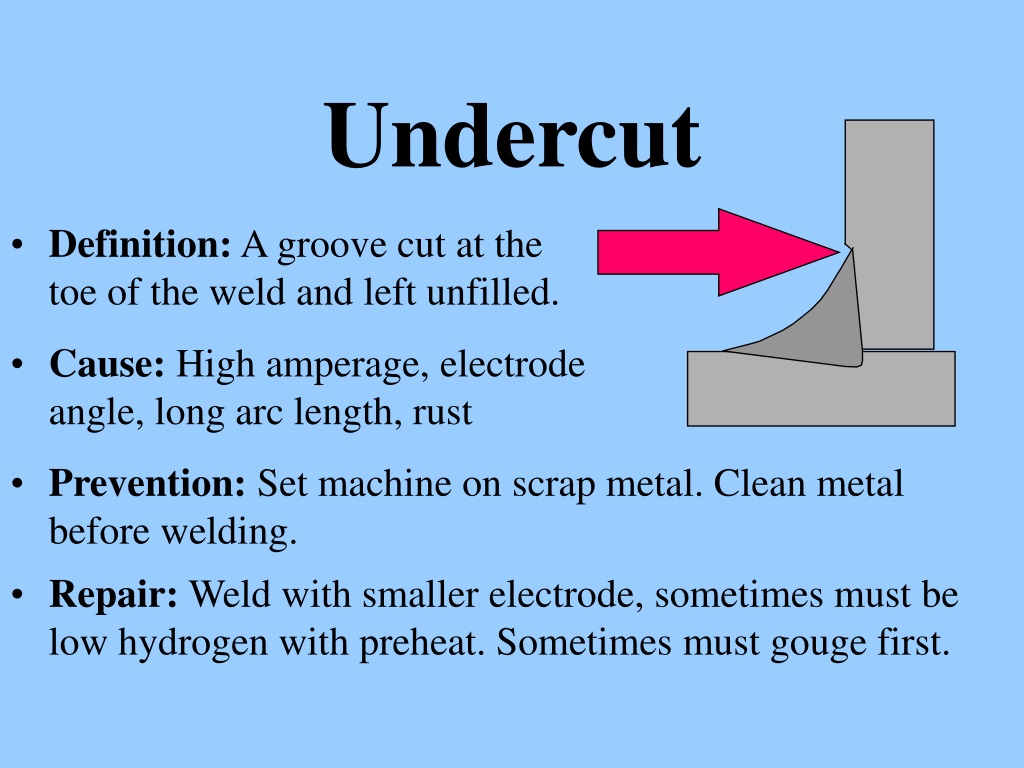Mastering the Art of Welding: How to Prevent Undercut Welding Issues for Flawless Fabrication Results
By recognizing the origin creates of undercut welding and implementing effective methods to avoid it, welders can boost their craft to brand-new levels of excellence. In the quest of flawless construction outcomes, understanding the art of welding to prevent undercut problems is not just a skill but a requirement for those making every effort for excellence in their job.
Recognizing Undercut Welding

To stop undercut welding, welders ought to make certain correct welding criteria, such as changing the current, voltage, travel rate, and maintaining the right electrode angle. In addition, using the ideal welding technique for the certain joint arrangement is vital. Using weaving activities or backstepping techniques can assist make certain proper weld metal deposition and minimize the probability of undercut development. Regular evaluation of welds throughout and after the welding procedure is also crucial to catch any type of undercut very early and make necessary adjustments to stop additional problems. Preventing weld undercut. By comprehending the root causes of undercut welding and applying preventive procedures, welders can achieve premium, structurally audio welds.
Root Causes Of Undercut in Welding
Recognizing the aspects that add to damage in welding is vital for welders to produce top quality, structurally sound welds. Undercutting takes place when the weld steel does not appropriately fill the groove formed in between the base steel and the formerly deposited weld metal. Numerous variables can cause undercut in welding. One common reason is too much warmth input. Welding at heats for extensive periods can cause the base steel thawing more than wanted, bring about undercut. Inadequate welding wrong or current welding rate can likewise contribute to damage. Inadequate current may not give sufficient heat to thaw the base and filler metals properly, while too much speed can prevent appropriate fusion, creating undercut. Furthermore, improper electrode angles or inaccurate torch control techniques can produce areas of reduced weld metal deposition, promoting undercut. Understanding these causes and applying correct welding techniques can assist prevent damaging concerns, making sure durable and solid welds.
Techniques to stop Undercutting

To alleviate the risk of damaging in welding, welders can utilize critical welding strategies aimed at enhancing the high quality and honesty of the weld joints. One reliable method is to adjust the welding parameters, such as voltage, current, and travel speed, to guarantee appropriate warmth input and deposition. Keeping an ideal electrode angle and making sure constant traveling rate can additionally aid prevent undercut. Furthermore, utilizing the right welding strategy for the certain joint setup, such as weave or stringer grains, can add to minimizing damaging. Preventing weld undercut.
Employing back-step welding methods and controlling the weld bead account can also assist distribute warmth evenly and lessen the risk of undercut. look here Routine examination of the weld joint during and after welding, as well as applying quality guarantee measures, can help in attending to and finding damaging concerns immediately.
Relevance of Appropriate Welding Parameters
Choosing and preserving ideal welding specifications is vital for accomplishing effective welds with minimal problems. Welding specifications refer to variables such as voltage, existing, take a trip rate, electrode angle, and securing gas circulation price that straight affect the welding procedure. These specifications should be thoroughly adjusted based upon the sort of product being bonded, its density, and the welding strategy employed.
Proper welding specifications make sure the appropriate quantity of warmth is used to thaw the base metals and filler product evenly. If the criteria are established too expensive, it can bring about excessive heat input, causing spatter, burn-through, or distortion. On the various other hand, if the criteria are also low, insufficient blend, absence of penetration, or undercutting click site might occur.
Quality Control in Welding Procedures

Conclusion
To conclude, grasping the art of welding requires an extensive understanding of undercut welding, its causes, and strategies to avoid it. By guaranteeing proper welding criteria and executing quality control techniques, flawless manufacture results can be achieved. It is crucial for welders to constantly aim for quality in their welding operations to stay clear of undercut problems and generate top notch welds.
Undercut welding, a typical defect in welding procedures, takes place when the weld metal does not correctly load the groove and leaves a groove or anxiety along the bonded joint.To avoid undercut welding, welders need to guarantee correct welding parameters, such as readjusting the present, voltage, travel rate, and maintaining the correct electrode angle. Inadequate welding present or wrong welding speed can likewise add to damage.To minimize the risk of damaging in welding, welders can use tactical welding methods intended at enhancing the high quality and integrity of the weld joints.In verdict, grasping the art of welding needs a complete understanding of undercut welding, its reasons, and strategies to prevent it.